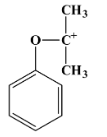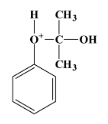
Explain the preparation of phenol from cumene.
Answer
504.6k+ views
1 likes
Hint:We get two products from this reaction. One of them is a ketone and the other one is an alcohol.
Complete step by step solution:
Let’s talk about cumene first. Its scientific name is isopropyl benzene. It is a natural by-product of the extraction of crude oil and coal tar which are petroleum products. Cumene is a colourless and volatile liquid which has a smell similar to gasoline. It is used in industries for the production of phenol on a large scale. The structure of cumene is as below:

The reaction of cumene that produces phenol is as shown below:

Taking the above reaction in a stepwise manner is good for health. It is as explained below:
- Cumene is first oxidised into cumene hydroperoxide by exposing it to air. This process is called air oxidation as no specific reagent is added to the reaction mixture for oxidising cumene. The product is a peroxide which means it has an “
- The degradation of cumene hydroperoxide occurs through hydrolysis in an acidic medium. The mechanism in this case involves a carbocation intermediate. The carbocation is tertiary in nature and has the following structure:

- The carbocation molecule is then attacked by another water molecule, which gives the following product:

- The positive charge on the oxygen atom directly attached to the benzene ring is due to the bonding of oxygen to three atoms while its valency is only two. This creates instability in the structure. The bond between
Note:
- This reaction is only possible in an acidic medium.
- This reaction is mainly used in industries. Replicating the same in laboratories is not possible because of the air oxidation process that requires heavy and complex equipment.
Complete step by step solution:
Let’s talk about cumene first. Its scientific name is isopropyl benzene. It is a natural by-product of the extraction of crude oil and coal tar which are petroleum products. Cumene is a colourless and volatile liquid which has a smell similar to gasoline. It is used in industries for the production of phenol on a large scale. The structure of cumene is as below:

The reaction of cumene that produces phenol is as shown below:

Taking the above reaction in a stepwise manner is good for health. It is as explained below:
- Cumene is first oxidised into cumene hydroperoxide by exposing it to air. This process is called air oxidation as no specific reagent is added to the reaction mixture for oxidising cumene. The product is a peroxide which means it has an “
- The degradation of cumene hydroperoxide occurs through hydrolysis in an acidic medium. The mechanism in this case involves a carbocation intermediate. The carbocation is tertiary in nature and has the following structure:

- The carbocation molecule is then attacked by another water molecule, which gives the following product:

- The positive charge on the oxygen atom directly attached to the benzene ring is due to the bonding of oxygen to three atoms while its valency is only two. This creates instability in the structure. The bond between
Note:
- This reaction is only possible in an acidic medium.
- This reaction is mainly used in industries. Replicating the same in laboratories is not possible because of the air oxidation process that requires heavy and complex equipment.
Latest Vedantu courses for you
Grade 11 Science PCM | CBSE | SCHOOL | English
CBSE (2025-26)
School Full course for CBSE students
₹41,848 per year
Recently Updated Pages
Master Class 9 General Knowledge: Engaging Questions & Answers for Success

Master Class 9 English: Engaging Questions & Answers for Success

Master Class 9 Science: Engaging Questions & Answers for Success

Master Class 9 Social Science: Engaging Questions & Answers for Success

Master Class 9 Maths: Engaging Questions & Answers for Success

Class 9 Question and Answer - Your Ultimate Solutions Guide

Trending doubts
State and prove Bernoullis theorem class 11 physics CBSE

Who built the Grand Trunk Road AChandragupta Maurya class 11 social science CBSE

1 ton equals to A 100 kg B 1000 kg C 10 kg D 10000 class 11 physics CBSE

State the laws of reflection of light

One Metric ton is equal to kg A 10000 B 1000 C 100 class 11 physics CBSE

Difference Between Prokaryotic Cells and Eukaryotic Cells




